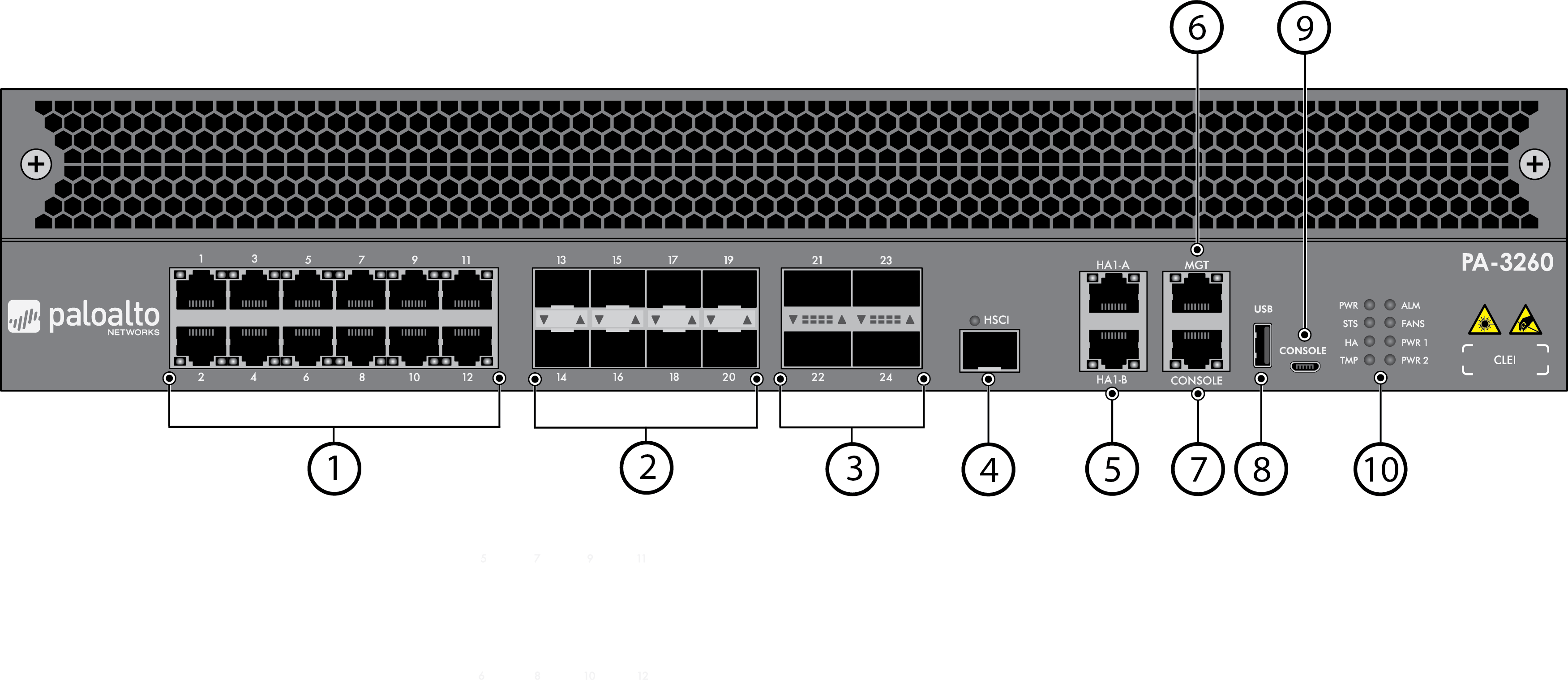Product Description
Overview:
The Palo Alto® PA-3200 Series next-generation firewalls are designed for data center and internet gateway deployments. This series is comprised of the PA-3260, PA-3260, and PA-3260 firewalls. These models provide flexibility in performance and redundancy to help you meet your deployment requirements. All models in this series provide next-generation security features to help you secure your organization through advanced visibility and control of applications, users, and content.
First Supported Software Release: PAN-OS® 8.1
Features:
- 8.8 Gbps firewall throughput1
(App-ID enabled1) - 4.7 Gbps Threat Prevention throughput2
- 4.8 Gbps IPsec VPN throughput
- 3,000,000 max sessions
- 135,000 new sessions per second3
- 6,000 IPsec VPN tunnels/tunnel interfaces
- 2,048 SSL VPN Users
- 10 virtual routers
- 1/6 virtual systems (base/max4)
- 60 security zones
- 5,000 max number of policies
Front Panel:

| Item | Component | Description |
|---|---|---|
| 1 | Ethernet ports 1 through 12 | Twelve RJ-45 10Mbps/100Mpbs/1Gbps ports for network traffic. The link speed and link duplex are auto-negotiate only. |
| 2 | SFP ports 13 through 20 | These ports vary depending on your firewall model:
|
| 3 | QSFP+ ports 21 through 24 | (PA-3260 only) Four QSFP+ (40Gbps) ports as defined by the IEEE 802.3ba standard. |
| 4 | HSCI port | One SFP+ (10Gbps) port (supports only an SFP+ transceiver or passive SFP+ cable). Use this port to connect two PA-3200 Series firewalls in a high availability (HA) configuration as follows:
The HSCI ports must be connected directly between the two firewalls in the HA configuration (without a switch or router between them). When directly connecting the HSCI ports between two PA-3200 Series firewalls that are physically located near each other, Palo Alto recommends that you use a passive SFP+ cable. For installations where the two firewalls are not near each other and you cannot use a passive SFP+ cable, use a standard SFP+ transceiver and the appropriate cable length. |
| 5 | HA1-A and HA1-B ports | Two RJ-45 10Mbps/100Mbps/1000Mbps ports for high availability (HA) control. If the firewall dataplane restarts due to a failure or manual restart, the HA1-B link will also restart. If the dataplane restarts and only HA1-B is connected, a split brain condition occurs. The HA1-A link will not restart when the dataplane restarts. Because of this behavior, we recommend that you connect both HA1-A and HA1-B to provide redundancy for the control link and to avoid split brain issues. |
| 6 | MGT port | Use this Ethernet 10Mbps/100Mbps/1000Mbps port to access the management web interface and perform administrative tasks. The firewall also uses this port for management services, such as retrieving licenses and updating threat and application signatures. |
| 7 | CONSOLE port (RJ-45) | Use this port to connect a management computer to the firewall using a 9-pin serial-to-RJ-45 cable and terminal emulation software. The console connection provides access to firewall boot messages, the Maintenance Recovery Tool (MRT), and the command line interface (CLI). If your management computer does not have a serial port, use a USB-to-serial converter. Use the following settings to configure your terminal emulation software to connect to the console port:
|
| 8 | USB port | A USB port that accepts a USB flash drive with a bootstrap bundle (PAN-OS configuration). Bootstrapping speeds up the process of configuring and licensing the firewall to make it operational on the network with or without internet access. |
| 9 | CONSOLE port (Micro USB) | Use this port to connect a management computer to the firewall using a standard Type-A USB-to-micro USB cable. The console connection provides access to firewall boot messages, the Maintenance Recovery Tool (MRT), and the command line interface (CLI). Refer to the Micro USB Console Port page for more information and to download the Windows driver or to learn how to connect from a Mac or Linux computer. |
| 10 | LED status indicators | Eight LEDs that indicate the status of the firewall hardware components (see Interpret the PA-3200 Series Status LEDs ). |
Back Panel:

| Item | Component | Description |
|---|---|---|
| 1 | System drive | One 240GB solid-state drive (SSD) used to store the PAN-OS system files, system logs, and network traffic logs. |
| 2 | Exhaust fan tray | Provides ventilation and cooling for the firewall. |
| 3 | Ground studs | Use the two-post ground stud to connect the firewall to earth ground. The firewall ships with a 6AWG two-post ground lug (attached to the ground studs) but does not include a ground cable. |
| 4 | PS1 and PS2 power supplies | Use the power supply inputs (either AC or DC depending on the installed power supply type) to connect power to the firewall. The second power supply is for redundancy. When facing the back of the firewall, PS1 is on the left and PS2 is on the right. |
Other Details
(Manufacturer Standard Warranty) - Not Clear what product you need, or can't find your specific product/service part number? Call us +1 888 988 5472 | Fax: +1 888 920 3445. You can also use the quote request pageProduct Videos
Custom Field
MPN PAN-Service-4HR-PLAT-3260-3YR
NOTE Images may not be exact, please check specifications.
Required A Volume Purchase Contact us for a volume pricing | volumeorders@hssl.us
 US Dollars
US Dollars
 United Arab Emirates Dirham
United Arab Emirates Dirham
 Euro
Euro
 British Pound
British Pound
 Turkish Lira
Turkish Lira
 Canadian Dollar
Canadian Dollar
 South African Rand
South African Rand
 Indian Rupee
Indian Rupee
 Brazilian Real
Brazilian Real
 Indonesian Rupiah
Indonesian Rupiah
 Singapore Dollar
Singapore Dollar
 South Korean Won
South Korean Won
 Japanese Yen
Japanese Yen
 Chinese Yuan
Chinese Yuan
 Mexican Peso
Mexican Peso
 Qatari Rial
Qatari Rial
 Saudi Riyal
Saudi Riyal












